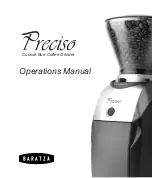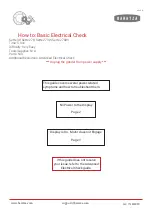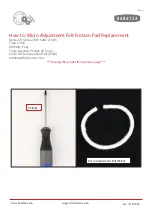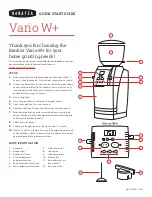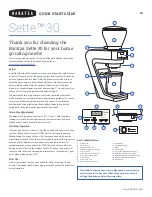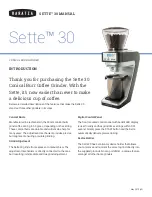
8
9
b. Remove the water filter holder from the
coffeemaker by lifting it out of the
reservoir area with your thumb and
forefinger.
c. Hold the water filter holder lengthwise
and place thumbs in slots directly under
arrows.
d. Pull open in opposite directions with
thumbs.
e. Place the filter in the holder recess area
at the bottom of the water filter holder.
NOTE:
Caution must be used when
inserting the charcoal water filter. Improper
placement in the holder can cause tearing
of the filter skin.
f. Close the water filter holder; you will
hear a snap indicating it is in place.
g. Hold the filter under cold running tap
water for 10 seconds to flush. You
should place the hole openings in the
side of the unit directly under the water
stream.
h. Allow the filter to drain completely.
i. Replace the water filter holder in the
reservoir area of the coffeemaker,
pushing it all the way down to the base
of the unit.
NOTE:
We recommend changing the water
filter every 60 days or 60 uses – more often
if you have hard water.
Replacement water filters can be
purchased in stores, by calling customer
service at 1-800-472-7606.
2. Fill the water reservoir
Open the reservoir cover by lifting it up.
Pour the desired amount of water in the
reservoir using the step water level
indicator located at the rear of the reservoir.
3. Add the ground coffee
Remove the filter basket by grasping the
handle and lifting straight up, and then
place it on the countertop. Insert a #4
paper filter or permanent filter. Be sure that
the paper filter is completely open and fully
inserted in the basket. It may help to fold
and flatten the seams of a paper filter
beforehand. Add the desired amount of
ground coffee, corresponding to the
number of cups being brewed. Many coffee
bars and the Specialty Coffee Association
of America recommend adding 2 rounded
tablespoons (30 ml) of coffee per 6 ounces
(170 ml) of water. Some coffee manu-
facturers recommend using 1 tablespoon
(15 ml) per cup. We recommend using
1 tablespoon (15 ml) of ground coffee per
cup, but use more or less to suit your taste.
NOTE: The maximum capacity for
ground coffee is 15 tablespoons (225 ml)
for this coffeemaker. Exceeding this
amount may cause overflow if the coffee
is too finely ground.
Replace the filter basket in the filter basket
holder and flip the water reservoir cover
closed. Press firmly on cover to be sure
that it closes securely.
Before brewing coffee
Make sure you have replaced the glass
carafe in its position on the heating plate
and closed the top cover. Plug the cord
into an electrical outlet.
4. Power unit
Turn the function knob to brew, press the
on/off button, and the red indicator light will
turn on. Or, set the Auto On function and
the green indicator will light.
5. During and after brewing
The Brew Pause™ feature allows you to
remove the carafe from the plate during
mid-brew. The brewing process does not
stop during this period – only the flow of
coffee from the basket stops. Do not
remove the carafe for longer than 30
seconds or the coffee may overflow the
basket. While we offer this feature, we do
not recommend that you pour the coffee
before the cycle has reached completion,
since the coffee brewed at the beginning of
the cycle has a flavour profile which is very
different from the flavour at the end of the
cycle. Removing a cup during the brewing
cycle will alter the flavour of the finished
pot.
Once the coffee has finished brewing,
stir it before serving to blend the flavours.
The coffee at the bottom of the carafe
will be somewhat stronger than the
coffee at the top.
When the brewing cycle has been
completed, five beeps will sound.
Coffee will continue to stream from
the filter for several seconds.
CLEANING AND
MAINTENANCE
Always turn coffeemaker OFF and remove the
plug from the electrical outlet before cleaning.
Lift up the reservoir cover. Remove and discard
the paper filter and ground coffee. The filter
basket can be washed in warm, soapy water
and rinsed thoroughly, or cleaned in the upper
rack of the dishwasher. Dry all parts after use.
Do not put any water in the unit once the
filter basket has been removed. Wipe the
area under the filter basket with a damp
cloth.
Remove the carafe from the resting plate.
Discard any remaining coffee. The carafe and lid
can be washed in warm, soapy water and rinsed
thoroughly, or placed in a dishwasher. The
carafe and carafe lid should be placed on the
upper rack only.
Do not use any scouring agents or harsh
cleansers on any part of the coffeemaker.
Never immerse base unit in water or other liquid.
To clean base, simply wipe with a clean, damp
cloth and dry before storing. Fingerprints and
other blemishes on the stainless steel housing
can be washed off with soap and water or a
nonabrasive cleaning solution. Wipe resting
plate with a clean, damp cloth. Never use rough,
abrasive materials or cleansers to clean the
resting plate. Do not dry the inside of the water
reservoir with a cloth, as lint may remain.
Decalcification
Decalcification refers to the removal of calcium
deposits which form over time on the metal
parts of the coffeemaker.
For best performance from your Cuisinart
Classic™ 12-Cup (1.8 L) Programmable
Coffeemaker, decalcify the base unit from time
to time. The frequency depends upon the
hardness of your tap water and how often you
use the coffeemaker. The flashing Clean light will
indicate when you should clean your
coffeemaker.
If the Clean light begins to flash when the
coffeemaker is turned on, it is telling you that
the calcium buildup is interfering with the
functioning of your coffeemaker and the flavour
of your coffee. To clean, fill the water reservoir
to capacity with a mixture of
1
/
3
white vinegar
and
2
/
3
water. Press the Clean button. When the
self clean light glows, turn the coffeemaker on
by pressing the on/off button. The Clean light
will shine steadily. The coffeemaker is now in
Clean mode. One cycle should be sufficient to
adequately clean the coffeemaker. When the
cycle is completed and the five beeps sound,
the coffeemaker will shut off. Turn the
coffeemaker on to see if the Clean light
continues to flash. If it does, turn it off and then
repeat the cleaning procedure with a fresh
solution of vinegar and water.
If the Clean light no longer flashes, turn the
coffeemaker off and then run one cycle of fresh
cold water through the unit before using the unit
again to brew coffee.
Notes on the Clean Function
Pressing the Clean button cancels all other
settings. If it is pressed accidentally, press it
again to return the coffeemaker to all its
previous settings. Pressing On/Off will also exit
the Clean Mode and turn the coffeemaker off.
06CC25135_DCC1100C_IB_BIL.indd 8-9
12/8/06 11:12:28 AM







